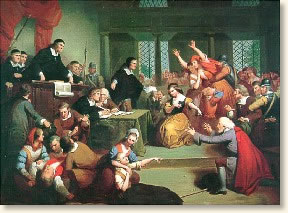 Puritan food was invented by Englishmen who didn’t approve of enjoying anything too much. Interestingly, what most people these days would think of as the archetypal New England food, clam chowder, appears to have been a later invention. Puritan staples were baked beans and rye ‘n’injun bread (corn and rye bread; wheat proved vulnerable to disease and was used only on special occasions). As everyone knows, Puritans also dressed austerely, extending to not bathing often. They wore “sadd” (serious) colors, though black was reserved for elders and authority figures, and passed sumptuary laws forbidding extravagance in dress to everyone.
Puritan food was invented by Englishmen who didn’t approve of enjoying anything too much. Interestingly, what most people these days would think of as the archetypal New England food, clam chowder, appears to have been a later invention. Puritan staples were baked beans and rye ‘n’injun bread (corn and rye bread; wheat proved vulnerable to disease and was used only on special occasions). As everyone knows, Puritans also dressed austerely, extending to not bathing often. They wore “sadd” (serious) colors, though black was reserved for elders and authority figures, and passed sumptuary laws forbidding extravagance in dress to everyone.The Puritan attitude toward recreation was that people should get enough recreation to maintain their physical and mental health, but not overdo it and engage in recreation just for fun. They recognized both that exercise is good for you and that people who never have any fun fall into dullness and discontent. Their favorite form of recreation was organized team sports. (This, perhaps, reflects their tight-knit nature. Having fun should be an organized community activity). Many of the team sports we play today originated in New England and were carried to other parts of the country by Yankee expatriates.
Virginians were notably hierarchical in their food, clothing and recreation. Food and clothing should not be surprising. Eating fancy food and wearing fine clothes are traditional privileges of wealth and rank. And, indeed, the gentry ate elaborate meals, with a focus on the “fricassee” or spiced, stewed meat. Plain folks ate more plainly. Feasting and entertainment were much practiced. Clothing was also hierarchical although, Fischer stresses, the gentry never dressed so extravagantly nor poor folks so miserably as in England. Sumptuary laws in Virginia were addressed less to curbing excess, but to keeping people from dressing above their station.
What may be surprising was that there was also a good deal of hierarchy in recreation. Horse racing was very popular, but only gentlemen were allowed to place bets . Male Virginians of all ranks engaged in blood sports, but there was a strict hierarchy in who was allowed to kill what. Gentlemen hunted deer and foxes. Common folk engaged in gander pulls, cock fighting and cockshairling (tying a rooster to a stake and killing it by throwing objects at it). Boys played “muzzle the sparrow," that is, they tied their hand behind their back, held a sparrow by the wing with their teeth, and tried to bite its head off. Puritans and Quakers regarded these sports as barbaric.
Quakers were an ascetic bunch, even more so than Puritans. Their food nonetheless sounds more appealing. It tended toward puddings and dumplings, and “cheeses.” “Cheese” did not mean cheese, but food slowly boiled down to preserve it. They ate cream cheese (Philadelphia!) and “fruit cheese,” meaning fruit boiled down and preserved with sugar and spices. Meat was also preserved by salt, sugar and smoking. They appeared to make heavy use of sugar as a preservative. Individually, their foods sounded attractive. Taken together, I would really miss something fresh. It impressed on me how fortunate we are to have refrigeration, so we can eat fresh food the year round and limit our sugar and salt if we so choose. Quakers dressed even more plainly than the Puritans, with plain gray clothes based on the Yorkshire style with no ornaments. Meetings carefully scrutinized people’s dress, to make sure there was no “needless” ornamentation. Women wore no makeup. Quakers did wear quality clothes, though. Wealthier Quakers wore the same plain clothes as others, but showed their status with quality materials and good workmanship.
Quakers also deeply distrusted recreation, allowing it only if it served some useful purpose. Blood sports were definitely condemned, but even ball games were distrusted. Still, children were encouraged to run and play because exercise was good for them. Adults were allowed recreations that might serve a useful purpose like skating (a form of transportation), swimming, hunting (for food only, not for the thrill of the kill), and gardening.

Backcountrymen ate a lot of what we think of as southern cooking – grits and fried pork. These were adaptations of border foods – oatmeal and fried mutton. Potatoes and “clabber” (curdled milk) were also popular. (Outsiders did not care for the clabber). They drank whiskey. Tea and coffee were fit only for the sick and the idle rich. Men dressed in what we generally think of as frontier clothes – western-style shirts, fringed leather and coonskin hats. Young women dressed for sex appeal, so much so that outsiders accused them of running around in their underwear. (Married women dressed more modestly).
Back settlers had at least some bloodthirsty forms of recreation, especially “wresting.” This could be done either according to rules (what’s the thrill in that?) or without rules. No rules meant no rules, not even against biting, eye gouging, or testicle crunching. The authorities tried to suppress these extreme sports, but audiences loved them. Backcountrymen also had more innocent contests, such as races, jumping, throwing contests, and the like. If our team sports came from the Puritans, our track and field contests came from the back country. Target shooting, imitating bird calls and other forms of woodsmanship were also popular.
